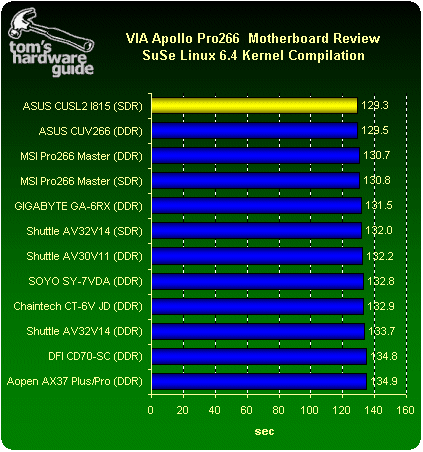DDR for Pentium III: 10 Boards with VIA Apollo Pro 266
Linux Kernel Compilation

Compiling a Linux kernel reveals hardly any differences between the individual boards and the reference values of the Intel 815. Many boards with DDR SDRAM are still in the lead, though.
Conclusion - Marginal Advantages To Using DDR SDRAM
This test of 10 boards with Apollo Pro 266 chipsets has proven that for your day-to-day business, using DDR SDRAM memory with the Pentium III doesn't offer any discernible advantages over using SDRAM memory (in combination with the Intel 815). Since Intel still only offers its own 815 chipsets for use with the Pentium III, the Apollo Pro 266 is a viable alternative.
Whoever wants to avail themselves of an appropriate board from this test series should select one of the combination boards. In this way, there is no need to purchase expensive DDR SDRAM memory. After all, you've got to spend $60 or more (especially for CL2) for a 128 MB DDR SDRAM module, whereas an SDRAM module only costs $30. In this case, the Shuttle AV32 is worth consideration. With all of its features and its combination interface, we heartily recommend this board.
At this juncture, we would like to mention that switching to a board with an Apollo Pro 266 chipset is only worth your while if you are really planning on using the new features, e.g. 6x USB or AGP 4x. Many users still have a board with an Intel 440BX chipset. Upgrading is really only useful if you are upgrading your CPU (e.g. to one with 133 MHz FSB) at the same time.
Stay on the Cutting Edge
Join the experts who read Tom's Hardware for the inside track on enthusiast PC tech news — and have for over 25 years. We'll send breaking news and in-depth reviews of CPUs, GPUs, AI, maker hardware and more straight to your inbox.
Current page: Linux Kernel Compilation
Prev Page OpenGL - Viewperf MedMCAD-01 Next Page A Closer Look At The Boards' ComponentsMost Popular

